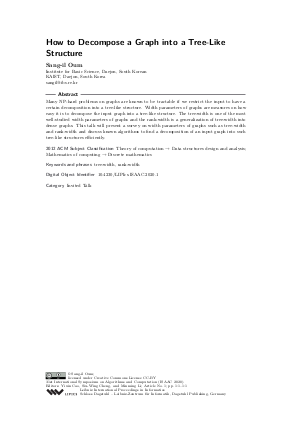How to Decompose a Graph into a Tree-Like Structure (Invited Talk)
Author Sang-il Oum
-
Part of:
Volume:
31st International Symposium on Algorithms and Computation (ISAAC 2020)
Part of: Series: Leibniz International Proceedings in Informatics (LIPIcs)
Part of: Conference: International Symposium on Algorithms and Computation (ISAAC) - License:
 Creative Commons Attribution 3.0 Unported license
Creative Commons Attribution 3.0 Unported license
- Publication Date: 2020-12-04
File

PDF
LIPIcs.ISAAC.2020.1.pdf
- Filesize: 155 kB
- 1 pages
Document Identifiers
Subject Classification
ACM Subject Classification
- Theory of computation → Data structures design and analysis
- Mathematics of computing → Discrete mathematics
Keywords
- tree-width
- rank-width
Metrics
- Access Statistics
-
Total Accesses (updated on a weekly basis)
0PDF Downloads0Metadata Views
Abstract
Many NP-hard problems on graphs are known to be tractable if we restrict the input to have a certain decomposition into a tree-like structure. Width parameters of graphs are measures on how easy it is to decompose the input graph into a tree-like structure. The tree-width is one of the most well-studied width parameters of graphs and the rank-width is a generalization of tree-width into dense graphs. This talk will present a survey on width parameters of graphs such as tree-width and rank-width and discuss known algorithms to find a decomposition of an input graph into such tree-like structures efficiently.
Cite As Get BibTex
Sang-il Oum. How to Decompose a Graph into a Tree-Like Structure (Invited Talk). In 31st International Symposium on Algorithms and Computation (ISAAC 2020). Leibniz International Proceedings in Informatics (LIPIcs), Volume 181, p. 1:1, Schloss Dagstuhl – Leibniz-Zentrum für Informatik (2020)
https://doi.org/10.4230/LIPIcs.ISAAC.2020.1
BibTex
@InProceedings{oum:LIPIcs.ISAAC.2020.1,
author = {Oum, Sang-il},
title = {{How to Decompose a Graph into a Tree-Like Structure}},
booktitle = {31st International Symposium on Algorithms and Computation (ISAAC 2020)},
pages = {1:1--1:1},
series = {Leibniz International Proceedings in Informatics (LIPIcs)},
ISBN = {978-3-95977-173-3},
ISSN = {1868-8969},
year = {2020},
volume = {181},
editor = {Cao, Yixin and Cheng, Siu-Wing and Li, Minming},
publisher = {Schloss Dagstuhl -- Leibniz-Zentrum f{\"u}r Informatik},
address = {Dagstuhl, Germany},
URL = {https://drops.dagstuhl.de/entities/document/10.4230/LIPIcs.ISAAC.2020.1},
URN = {urn:nbn:de:0030-drops-133458},
doi = {10.4230/LIPIcs.ISAAC.2020.1},
annote = {Keywords: tree-width, rank-width}
}
